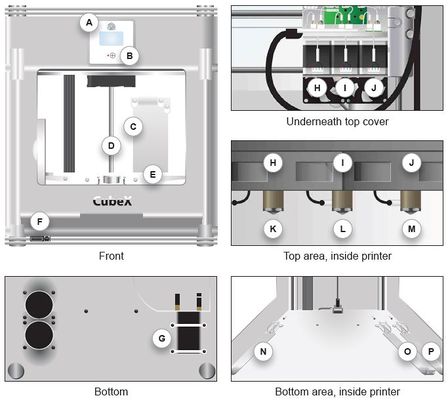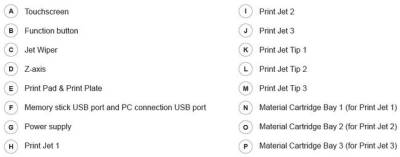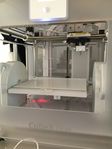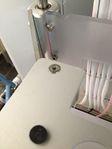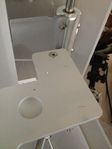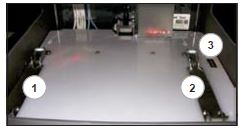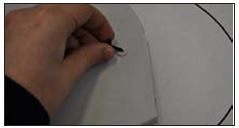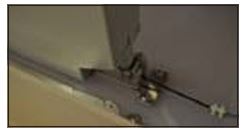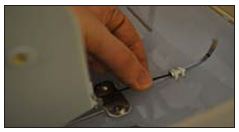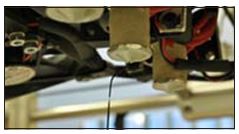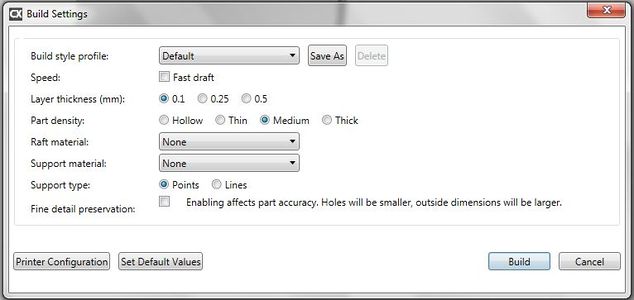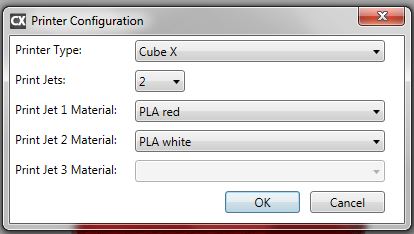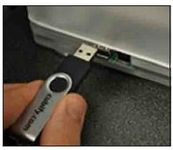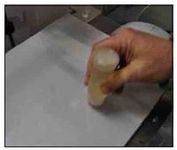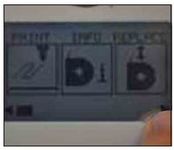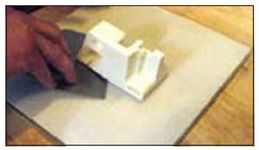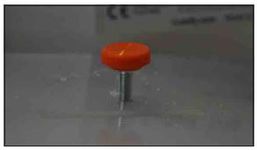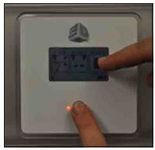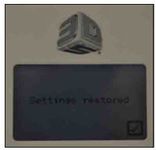Table of Contents
CubeX 3D Printer Tutorial
The CubeX 3D Printer creates three-dimensional parts with print tips that heat material to extrude a thin string of plastic which adheres to print pad layers. The print pad lowers after each layer so that each one builds upon the last. This process continues through the final layer, until your creation is complete.
General Overview: To begin the process of creating a printed part from a 3D model, design a part in a CAD package or download one from Cubify.com. Before the part can be printed, it must be opened into the CubeX Software (CubeX Software accepts both .stl and .creation files). The CubeX Software creates a .cubex file, which the CubeX uses to build the part. Save the .cubex file onto your USB drive and plug the drive into your CubeX. The CubeX creates the model by pulling filament from the cartridge through the print jets via the delivery tubes. The filament is then jetted through the print tip in a thin string of molten plastic. The print jet is accommodated by the print plate, which lowers incrementally after each layer is deposited so a new layer can be drawn on top of the last, building the part up.
The rest of this page goes into specific detail of how the CubeX printer works from experience using it and information from the user guide. The page will include details about:
- Information about the CubeX
- Safety guidelines when using and cleaning the CubeX
- Print material
- Printer Setup
- The Cubify Invent and CubeX Software
- Printing and
- Maintenance
Before you Begin
Weight and Dimensions
- 515mm(w) x 515mm(l) x 598mm(h)
- 36kg (79 lbs)
- 37kg (81.5 lbs) Duo
- 38kg (84 lbs) Trio
Minimum Hardware requirements
- Processor: Multi-core processor - 2GHz or faster per core
- System RAM: 2 GB
- Screen Resolution: 1024 x 768
Software
- Cubify Invent software can be installed from the USB provided in the CubeX toolkit
- CubeX software can be downloaded from Cubify.com
Safety Guidelines
- Do not make modifications to the CubeX or safety features of the CubeX. Doing so is strictly prohibited and voids your warranty.
- Use of 3D print materials or parts other than genuine 3D Systems® components may void your warranty.
- Adult supervision is required; watch children closely and intervene as necessary to ensure appropriate use of the CubeX and
prevent potential safety hazards. Ensure that small 3D prints are not accessible to young children, as they may pose choking hazards.
- The print tip of the print jet becomes very hot when the CubeX is operating; avoid touching this area until it has cooled down.
- Do not change material color during printing; doing so may damage your CubeX.
Printer Features and Benefits
Printer Features
- Plastic Jet Printing technology
- Houses up to three print jets for multi-color and multi-material prints
- Over material choices
- Choices between ABS and PLA plastic, both oh which are recyclable
- Prints objects up to 275 x 265 x 240 mm (10.75“ x 10.5” x 9.5“)
- EZ load print cartridge
- Fully automated supports: peel off supports for ABS and PLA
- PLA supports can also be removed using the Ultrasonic Support Removal Tank available at Cubify
Print Materials
The CubeX can use two different types of print materials: PLA and ABS. Each material has unique benefits and you can guide your selection based on the properties your part requires.
PLA
This is a hard plastic that has a low environmental impact. It is derived from renewable, starch-based resources. We recommend using PLA when printing extra-large parts on CubeX as it is a more stable print material. PLA is the optimal support material for industrial ABS parts. PLA has the ability to dissolve away in caustic soda solutions supported by an ultra-sonic tank.
ABS
This is a well-known plastic known for its strength and industrial properties. As a build material, ABS is good for both small and large parts. ABS works as an excellent support material for extra-large PLA parts.
At a Glance
Menu Overview
Setup
Installing the Print Pad
1. Scroll to the “MOVE” function screen located on the CubeX control panel.
2. Using the Up and Down arrows on the right side of the screen, move the Aluminum Print Plate to a low position.
3. To install the Print Pad, align the aluminum foot with front slot on the Print Plate base.
4. Place the Print Pad into position, when properly installed the magnet will lock it in place. Ensure that the print pad is fully seated.
Leveling the Print Pad
1. Scroll to the "LEVEL" function screen located in the CubeX control panel.
2. Using the arrows, adjust the distance between the print jet and print pad to approximately 10mm. Tap on the clockwise and counterclockwise position and observe the print jet’s print jet tip moves around the print pad from the side of pad, checking for inconsistencies in the gap distance between the jet and pad.
3. Remove the print pad off of the print plate. Near the front and back corners of the print plate are three bolts that can be adjusted to change the height of the plate. There are locking nuts under each of these bed bolts that must be loosened with the 8mm spanner wrench before the bolts can be adjusted.
4. To adjust the height of the print plate, use the 3mm hex driver from the tool kit to adjust the height of the three bolts to ensure the plate is leveled evenly.
5. After adjusting the print plate, place the print pad back on and continue using the arrows, clockwise and counterclockwise buttons to check the gap length between the jets and pad.
It may take several Print Jet movements and bolt adjustments to ensure that the Print Plate is level.
6. Once you have finished leveling the entire print plate, make sure the locking nuts are tightened and secure and place the print pad back on the print plate. Exit the "LEVEL" function by pressing the control button.
Checking the Z-Gap
Remember to adjust the print jet gap after leveling the print pad
1. Scroll to “Z GAP” using the arrows on the touchscreen. Select Z GAP and using the “Up / Down” arrows, move the print pad up so that it is just touching the tip of the print jet.
2. Using the “Down” arrow, lower the printpad down by 0.1 from the print jet tip. Click on the Control button, the next screen will allow you to save the setting. Click on the check mark to save or the X to cancel the setting.
Installing a Material Cartridge
1. Press REPLACE on the touchscreen and select the bay that the cartridge will be installed. Print Jet 1 represents bay 1, Print Jet 2 represents bay 2 and Print Jet 3 represents bay 3. Press “Next” on the touchscreen, a message “Heating Print Jet Please Wait…” will appear on the control panel.
2. Remove the thumbscrew from the new cartridge and retain thumbscrew to use when storing the used cartridge that has material inside. This will prevent the material from unraveling when stored.
3. Pull 300mm (11”) of material from the new cartridge and cut 50mm (1.5”) from the end of the filament. 4. Thread the filament under the cartridge clamp bar and into the feed tube.
5. Install the new cartridge from the side of CubeX and into the cartridge bay.
6. Push filament between the front of cartridge and the eyelet, through the feed tube and up to the print jet.
7. When the material jets from the print jet tip, the next screen will ask if you want to replace another cartridge. If replacing another or adding cartridge, select the print jet’s material cartridge to be replaced and repeat steps 2-7. Otherwise, select X to return to the main menu.
Replacing a Material Cartridge
1. Press REPLACE on the touchscreen and select the bay that the cartridge will be installed. Print Jet 1 represents bay 1, Print Jet 2 represents bay 2 and Print Jet 3 represents bay 3. Press “Next” on the touchscreen, a message “Heating Print Jet Please Wait…” will appear on the control panel.
2. After the print jet is heated, the next message will appear asking to “Gently Pull Filament From Feed Tube.” Gently pull the filament in between the cartridge front holder and eyelet as shown. Press “Next” on the touchscreen.
3. A message “Install Thumbscrew into Cartridge” will appear. If a cartridge is being replaced, ensure that the thumbscrew is installed into cartridge if it is to be stored.
4. Press “Next” on the touchscreen. A message “Would you like to load a new Print Jet” will appear on the touchscreen. Select the check box and refer to '''Installing a Material Cartridge''' to install the new cartridge or repeat this process to replace an existing cartridge.
The CubeX Software
CubeX software can be downloaded from Cubify.com
The CubeX software is used to make last minute modifications such as scale, color, and position of the model on the print pad before it prints. It is also here where .stl files made in Cubify Inventor or downloaded from Cubify are converted and built into .cubex files for printing.
CubeX Software User Interface
Home Tab
STL File
| Button | Description |
|---|---|
| Open | Opens a .stl file |
| Open Model Assembly | Opens a multi-part assembly of .stl files |
| Close | Close the open .stl file |
| Close All | Close all open .stl files |
| Save As | Save the current open .stl file |
| Single Color | .stl File will be loaded in a single color |
Move Geometry
| Button | Description |
|---|---|
| Move X | Translate the 3D model about the X axis by the specified amount |
| Move Y | Translate the 3D model about the Y axis by the specified amount |
| Auto Place | Automatically places .stl files which are already open |
| Move Model | Drag the model |
Scale Geometry
| Button | Description |
|---|---|
| % Scale | Scale the part by the specified percentage |
| To mm | Change a part from inches to mm |
| To inches | Change a part from mm to inches |
| Revert | Undo changes made using the Scale Geometry options |
Rotate Geometry
| Button | Description |
|---|---|
| X/Y/Z | Rotate the part by the specified number of degrees |
| Revert | Undo changes made using the Rotate Geometry options |
Pick Color
Select which Print Jets print which parts. The available options will vary depending on how many Print Jets you have active and what colors are loaded into them. The settings can be adjusted in the Printer Configuration
Print File
| Button | Description |
|---|---|
| Open | Opens a .cubex file |
| Close | Close the open .cubex file |
| Save Print File | Save the current open .cubex file |
| Build | Opens the build settings window. Build time is dependent on the model size and layer thickness. |
For larger models or models that require higher resolution, more time will be needed.
- Build Style Profile allows you to save any changes made to the build settings and load previously saved ones
- Fast draft is the fastest setting for the printer, but will produce a lower quality product
- Layer thickness determines the quality of the part. Smaller layers lead to higher quality while larger layers lead to lower quality.
- Part density determines the structure of the inside of the part
- Raft/Support material - select ink to be used to create raft or support when making the part
- Support type - choose between points or lines as your support material if using any
- Fine detail preservation - Enabling this will preserve finer details of your part, but may affect accuracy.
View Tab
Zoom
| Button | Description |
|---|---|
| Zoom In | Press to zoom in |
| Zoom Out | Press to zoom out |
| Fit to Window | Centers back on to the piece |
View
| Button | Description |
|---|---|
| Top View | View the part from above |
| Front View | View the part from the front |
| Left View | View the part from the left |
| Right View | View the part from the right |
Print Paths
These options become toggle-able once the model has been Built and converted into a .cubex file
| Button | Description |
|---|---|
| Show Print Jet 1 | Toggle to show the print paths for print jet 1 in a .cubex file |
| Show Print Jet 2 | Toggle to show the print paths for print jet 2 in a .cubex file |
| Show Print Jet 3 | Toggle to show the print paths for print jet 2 in a .cubex file |
| Show All Layers | Toggle to show all layers or to show one layer at a time. Scroll through the layers using the scroll bar found down the right hand side of the window. |
Settings Tab
| Button | Description |
|---|---|
| Printer Configuration | Opens the printer configuration window. |
| Build Settings | Opens the build settings window. |
| Firmware update | Used to update the CubeX 3D Printer firmware. |
- Printer Type - select the 3D Printer model being used
- Print Jets - number of print jets to be used.
- Print Jet Material - select what type of material will be used int he cartridge
Opening a .stl File
1. Click on OPEN MODEL or OPEN MODEL ASSEMBLY depending on how many parts you want to work with on the bed. Using OPEN MODEL ASSEMBLY will allow for individual parts to be imported, but be treated as one .stl file while using OPEN MODEL still treats each part as separate .stl files.
2. The file will appear in the center of the print bed. If you are loading multiple parts, every part will appear merged together in the center. These parts are still separate and can be dragged away from each other manually or automatically by clicking the auto place button.
If printing with a single material, keep Single Color toggled ON
Creating a .cubex File
1. Once you have finished loading all the needed parts, you can change each part's individual color, size, and orientation using the tools in the Home Tab.
2. Once you are done editing your part, you can convert it to a .cubex file by clicking the BUILD icon. Doing so will open the build settings window where you can change the build style of the part.
3. Once the build is complete, the window will display the estimated amount of time needed to construct the part and the amount of material that will be consumed.
4. Click Save Print File and save the .cubex file onto a USB that will transfer the .cubex file to the CubeX.
Printing
Printing your Creation
1. Insert the USB stick containing your .CUBEX file (creation files) into the USB port on the CubeX.
2. Use the Magic CubeX Glue to coat the Print Pad with a layer of glue. Turn the CubeX Glue upside down so the glue flows to the tip. If the print is large, ensure that the glue covers the Print Pad surface where the creation will print. If it is a smaller print, cover the middle of Print Pad with the glue.
3. Select the ‘Print’ option from the main menu.
4. Using the arrows at the bottom of the screen, scroll to the .CUBEX file you wish to print and tap on the file name. Your creation will begin to print.
Finishing your Creation
Before you attempt to remove your creation from the Print Pad, please ensure that the CubeX has finished printing and that the Print Pad has moved to the bottom of the CubeX.
1. Lift the Print Pad from the side and pull up to remove the Print Pad from the CubeX.
2. Using the scraper (included in tool kit), gently release your creation from the glass.
Removing Rafts
A raft is the flat support structure that is attached to your creation. Though we recommend printing without a raft, some larger or more complicated parts may require one. If you print with a raft, the following instructions will help you remove it:
| Header text | Header text |
|---|---|
| ABS RAFT / PLA PART - PLA RAFT / ABS PART | ABS rafts can be peeled away from PLA parts. |
| ABS RAFT / ABS PART - PLA RAFT / PLA PART | Use pliers to pull away as much of the raft as possible. Then use a rough-grade sandpaper to remove the remaining raft, followed by a fine-grade wet and dry sandpaper to achieve a smoother finish. |
Removing Supports
Use wire cutters to cut away the support structure from your model. You should cut the supports at the point where they touch the model.
CubeX Maintenance
Restoring roughness to the Print Pad
To restore roughness to the Print Pad, run the sandpaper included in your toolkit diagonally across the bed corner to corner in both directions.
Cleaning the Print Pad
To clean the Print Pad, rinse the pad under hot water to clean off any remaining Magic CubeX Glue paste. Dry the Print Pad thoroughly before reinstalling it into CubeX.
Leveling the Jet Wiper Height
If your Jet Wiper is set too low or too high, you can adjust it using the orange capped bolt located under the print jet, screwing it into the floor to set the Jet wipe lower and unscrewing it to set the Jet Wipe higher.
You will first need to ensure that your aluminum pad support is level. After this you can install the Print Pad and fine-tune the leveling.
Unblocking the Print Jet Tip
If your CubeX will not jet material, you can unblock the print jet tip by going into ‘PJ-CONN’ from the main menu and heating the tip to 260°C. Using the 0.5mm drill bit from the tool kit (a drill is not needed), feed the drill bit into the print jet tip, being careful not to bend the drill bit. Remove the drill bit and set the motor to 3RPM. Repeat this process until the print jet tip jets.
THE DRILL BIT AND THE PRINT JET TIP CAN BECOME HOT WHEN UNBLOCKING THE PRINT JET TIP. USE HEAT RESISTANT GLOVES WHEN UNBLOCKING THE CUBEX PRINT JET TIP.
If the print jet tip still won’t jet material after unblocking it, you may need to unblock the print jet. First remove the delivery tube face plate and take out the cartridge, removing all filament from the corresponding cartridge bay, delivery tube and print jet. Then go into ‘PJ-CONN’ from the main menu and set the print jet temperature to 260°C. Once this temperature has been reached, insert an unfolded paper clip into the print jet through the filament loading hole and push it in as far as possible. Run the print jet at 2RPM and gently push down on the paper clip until you feel resistance. Start reversing the print jet at -2RPM and slowly pull the paper clip back out of the print jet. Reload the cartridge and filament back into the print jet and try to jet material again. If your print jet still won’t jet material at this point, contact Cubify support.
PRINT JET TIP BECOMES EXTREMELY HOT DURING SET-UP AND OPERATION. DO NOT TOUCH PRINT JET TIP.
Updating the CubeX Firmware
If you are unsure what version of firmware is currently installed on your CubeX 3D Printer, navigate to the UPDATE button on the main menu and the version number will be located beneath it.
1. Plug your USB stick into the CubeX 3D Printer.
2. Navigate to the “Update” button on the main menu. Press and hold the "Update" button.
3. Press the tick on the screen to put the CubeX 3D Printer into boot loader mode. Release the function button after “Setting saved” message disappears. Your printer is now in firmware mode.
4. Remove the USB stick from the CubeX 3D Printer and open the CubeX software on your computer.
5. Plug your CubeX into the computer using the PC connection USB port.
6. Navigate to the settings tab to the CubeX software and press the Firmware update button.
7. The CubeX software will then open windows explorer. Navigate to the firmware you wish to install and open it. The CubeX software will now install the firmware onto the CubeX printer.
8. Once the firmware is installed unplug the printer from the main power for 30 seconds and unplug the USB from the computer.
9. Plug the USB stick into the CubeX 3D Printer and press the control button; you will receive a notification of your settings being restored.
10. Your firmware has now been upgraded.



